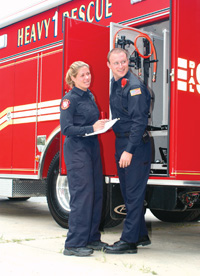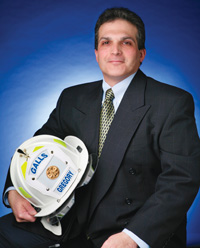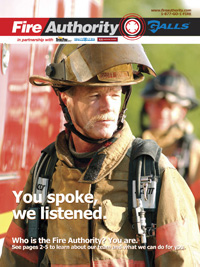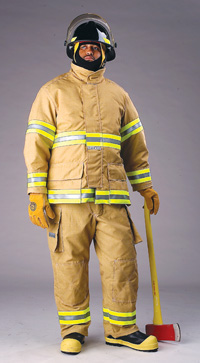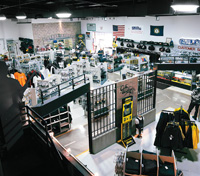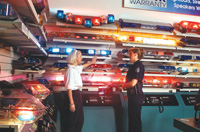|
By Margaret Buranen Seldom can an industry giant can be described as nimble, but that seems an accurate characterization of Galls. The company presents itself as the largest retailer of uniforms and equipment for firefighters, police officers, emergency medical technicians and other public servants. Alan Bloomfield founded Galls in Lexington, Ky., where the company headquarters is still located. In 1995, Bloomfield sold Galls to Aramark Corporation. Besides a mail order catalog division and a website with online ordering, there are seven Galls stores, with a total of approximately 700 employees. One store adjoins the corporate headquarters in Lexington. The remaining six stores are in California, located in San Francisco, Los Angeles, Long Beach, Orange, San Diego and Riverside. Three of these stores were bought from Long Beach Uniform in 2001. Galls stores average 12,000 to 15,000 square feet, but the San Diego store is 20,000 square feet. The Galls website includes a photograph of each store plus detailed directions from the nearest interstate or freeway. Quarterly sellout sales are held at the companys warehouse, also in Lexington, a few miles from the headquarters. Sales dates are posted on Galls website. Its not unusual for customers to take the day off work and drive 100 miles or more to take advantage of the sale prices. Besides overstocks, discontinued items and older versions of current merchandise are included. The perception and often the reality of a company with a large share of the market, one that is big enough to ship orders to more than 100 countries, frequently is an image of staid tradition. Such giant companies are slow to change, if not downright resistant to it. But at Galls, adaptability and customer-responsive change are the rule, not the exception. Nowhere is that more obvious than on the companys website, www.galls.com. Because its easy to provide feedback about a product, many customers do. Their comments, negative or positive, are posted for other customers to read and to add additional comments if they wish. Often the comments reflect on the customers job experiences this flashlight is fine for traffic stops, but too heavy to carry on patrol; if you carry lots of extra stuff, the pockets on these pants wont be large enough to hold everything. This feedback from customers and prospective buyers is carefully scrutinized by various Galls employees. David Robbins, Director of Profession and Channel Marketing, is among the ten or so employees who read the 50 to 100 customer comments received daily via the website. They pass printouts around and take note of trends. Any irate customer gets an immediate reply. We have a team to do that, Robbins says. He adds that sales team members also read the customers comments for possible leads. Responding to customers requests, complaints and suggestions is essential because our customers deal with reality, says Cary Gregory, Senior Vice President. And to ignore that would be bad business. A specific example of how customers ideas affected design and merchandising goes beyond one product. The entire new line for firefighters, called the 5.11 Response Series, is 100 percent designed by our customers, says Gregory. 5.11 Response is part of Galls new division for firefighters, called Fire Authority. No detail of the uniforms for the 5.11 Response Series was too small to be addressed. Customers were asked how many buttons jackets should have. Did they want documents pockets or not? What about cargo pockets? If the uniform pants have pockets, what size should they be? What should they be designed to hold? In deciding on pocket shape and size, the companys designers even procured and measured the most common brands of cell phones. Paramedics often complained that scissors kept in pockets on the legs of their pants either fell out, slipped out and ripped the pockets, or banged against doors; they were pleased with the addition of Velcro strips to hold the pockets closed. Galls uses focus groups and sends field representatives to talk to public servants around the country. When models of uniforms are finished, they are wear tested on customers in patrol cars, stationhouses, training sessions and obstacle courses, not in the store. But even coming up with good products that match many customers requests isnt sufficient for Galls. One size and style is not good enough to meet the specialized needs of its customers. The companys focus is always on the individual customer. For example, Galls may sell an order of uniforms and equipment for 100 or more firefighters in a large city, but each uniform ordered is customized to meet the wishes of the firefighter who wears it. Does he want a zip or button closing? Does she prefer a longer or shorter jacket? As the number of women serving in public safety jobs has increased over the years, Galls has increased its response to this niche market. The company designed uniforms and other items to fit women exclusively, rather than merely alter mens items. A Galls sales representative can offer shoes manufactured on lasts to fit womens feet, not just suggest that women customers try mens shoes in smaller sizes. The company sells maternity styled uniforms and mails out catalogs dedicated to womens apparel only. Part of Galls success can be attributed to being part of the Aramark Corporation. That corporate umbrella means that Galls has access to sufficient financial resources to research and launch new products and product lines. Aramarks ownership provides, as Gregory puts it, the wherewithal to do what needs to be done. The other reason for Galls success is its skill at and dedication to multi-channel marketing. This type of marketing means that Galls can both reach more customers in different markets and reach many of the same customers more than once through more than one market channel. Rather than compete for customers, the different channels reinforce each other. For example, a firefighter waiting at the stationhouse for a call may surf the Galls website and find more information about a pair of gloves or a flashlight that he spotted earlier in a Galls catalog. A paramedic may see a new style of shoes for women in a general Galls catalog but not order them until she compares the entire selection available in a catalog of women-only items. A police officer may want to check out an internet item with a customer service representative before he decides which version or size is best for him. Catalogs are a major sales and marketing channel for Galls. The company produces more than 20 different catalogs. Some are specific to a job field or sub-field. Others are general, with items useful for virtually any type of public service worker. Galls catalogs range in size from 68 pages to 600 pages. The typical size is about 340 pages. Online business is steadily increasing for Galls. But, according to Gregory, catalog business has not necessarily decreased because of the websites popularity. He explained that the website and the catalogs serve different purposes. The catalogs are marketed not only as tools to elicit immediate orders but as handy reference guides. The cross-promotion marketing strategy of Galls takes the long-term view that customers will order more and be more likely to find exactly what they need when they see the merchandise in different ways. Gregory notes that younger customers have been using computers for more years and are more comfortable in a web environment. Theyre more technology-savvy. To encourage catalog browsers to use the website, the catalogs include a double page spread showing the home page of Galls website. Clear instructions suggest how easy it is to use the site. Gregory, who held other marketing positions before joining Galls in 2005, says that his company is successful because of our people. Thats a clich, but we have passionate people who are passionate about serving our customers. Gregory points to one company slogan as one reason for the dedicated service: We protect people that protect the people. To learn more about their public servant customers, he and several other Galls executives went through both the Citizens Fire Academy and the Citizens Police Academy in Lexington. Each program lasted several months. Participants were able to experience some of the same training and on-the-job situations that firefighters and police officers do. Another example of what Gregory termed Galls strategy of getting close to the customer is demonstrating the safety of body armor sold to law enforcement officers. Galls executives go onto a firing range and set up targets of mannequins wearing the armor. After the mannequins are fired upon, officers can see for themselves that the armor meets National Institute of Justice certification. Customers can see for themselves that the armor really is as protective as the sales literature claims. Sometimes Galls efforts to connect to its customers are small, such as when some of its executives participated in judging a chili cook-off with some central Kentucky firefighters. Other efforts are major, such as the challenging task Galls took on to re-equip the New Orleans Police Department after Hurricane Katrina. The New Orleans Police Department chief and other city officials decided that the project should be completely finished by the beginning of Mardi Gras 2006, but funding was slow to support that timeline. In a little more than two months, Galls employees had to secure each police officers order for new uniforms and equipment, including personal preferences where permitted, arrange for alterations when needed, and process each order. Because there was no convenient and suitable building to work from, the crew from Galls set up a mobile tailors shop operation. The sheer range and depth of merchandise available to Galls customers would be nearly impossible for a small uniform company to offer. The companys financial resources are a tremendous advantage, allowing it to try new merchandise and to keep items which arent the top sellers in stock. Any company in the uniform business, no matter what size, can learn from the Galls operation. Gregory said that treating your customer with respect is always a good idea. You cant ever be too close to the customer, he emphasized. Customer-centric is a watchword for us. Galls continual striving to be as customer-responsive as possible can be emulated. As Galls in-store sale people do, talk to the customers about their purchases and pass on any suggestions they give you. As Galls outside sales reps do, check back with the business owner who purchased a big order of uniforms to see that all is well. But dont stop there; talk to the uniform wearers themselves. Allow for online feedback, and train those who take phone orders well so they know the merchandise well. GALLS |
|
| Above story first appeared in MADE TO MEASURE Magazine, Spring & Summer 2007 issue. All rights reserved. Photos appear by special permission. | |
| Halper Publishing Company 633 Skokie Blvd, #490 Northbrook, IL 60062 (877) 415-3300 Fax (224) 406-8850 [email protected] |
|





